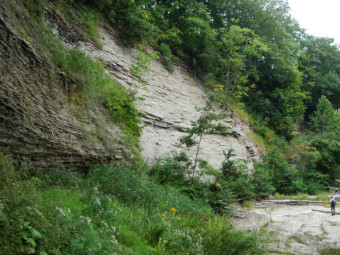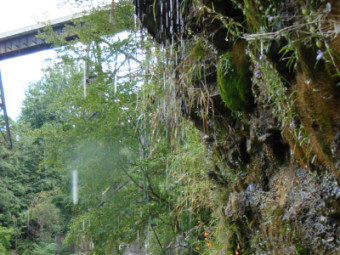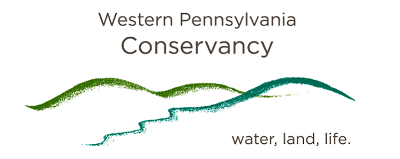River Bluff Seep
System: Palustrine
Subsystem: Herbaceous
PA Ecological Group(s):
Great Lakes Region Wetland
Global Rank:GNR
![]() rank interpretation
rank interpretation
State Rank: S1
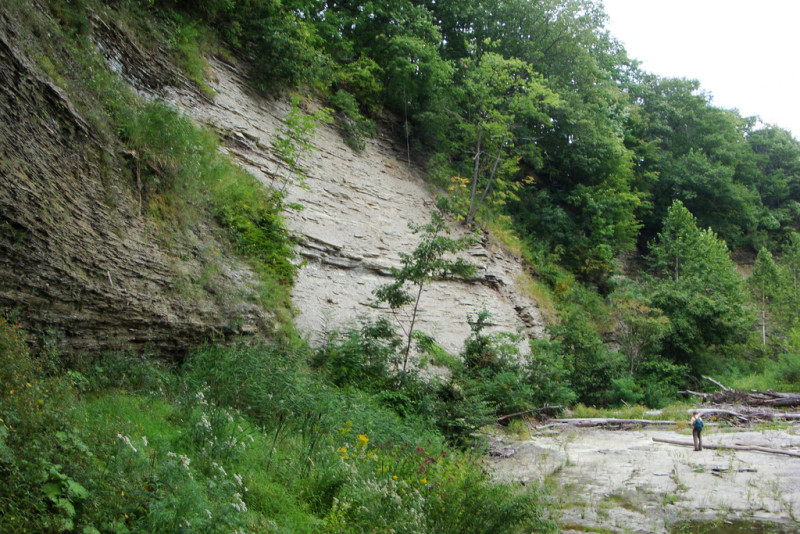
General Description
The River Bluff Seep is characteristically open and herbaceous. Limited to the steep gorge walls of tributaries to Lake Erie, large tree species are often prevented from growth by the saturated conditions, limited soils, and near-vertical conditions. The community may extend to saturated piles of rock and soil that accumulate at the base of the gorge walls. Herbaceous species include zigzag goldenrod (Solidago flexicaulis), Indian-tobacco (Lobelia siphilitica), jewelweed (Impatiens pallida), field horsetail (Equisetum arvense), golden ragwort (Packera aurea), Jack-in-the-pulpit (Arisaema triphyllum), fowl mannagrass (Glyceria striata). This type often supports golden-fruited sedge (Carex aurea), brook lobelia (Lobelia kalmii), and grass-of-Parnassus (Parnassia glauca).
Exotic species include common reed (Phragmites australis), colt’s-foot (Tussilago farfara), bittersweet nightshade (Solanum dulcamara) and narrow-leaved bittercress (Cardamine impatiens).
Unlike the Great Lakes Bluff Seep, this community is more often found on bedrock, where ground water, seeping out of the ground, high above the tributary floor has made growth of plants possible.
Rank Justification
Critically imperiled in the nation or state because of extreme rarity (often 5 or fewer occurrences) or because of some factor(s) such as very steep declines making it especially vulnerable to extirpation from the state.
Identification
- Located on steep slopes of shale or mud-stone bedrock of Lake Erie tributary gorges, in northwestern PA
- Found along areas of the scarp-slope with perennial seepage
- Vegetation is characteristically herbaceous dominated by forbs and graminoids
Shrubs
Herbs
- Great blue lobelia (Lobelia siphilitica)
- Field horsetail (Equisetum arvense)
- White-snakeroot (Ageratina altissima)
- Jewelweed (Impatiens capensis)
- Swamp milkweed (Asclepias incarnata)
- Golden ragwort (Packera aurea)
- Zigzag goldenrod (Solidago flexicaulis)
- Pale jewelweed (Impatiens pallida)
- Fowl mannagrass (Glyceria striata)
- Grass-of-parnassus (Parnassia glauca)
- Golden-fruited sedge (Carex aurea)
- Twisted sedge (Carex torta)
- Brook lobelia (Lobelia kalmii)
- Turtlehead (Chelone glabra)
- Bugleweed (Lycopus spp.)
* limited to sites with higher soil calcium
Vascular plant nomenclature follows Rhoads and Block (2007). Bryophyte nomenclature follows Crum and Anderson (1981).
International Vegetation Classification Associations:
USNVC Crosswalk:None
Representative Community Types:None
NatureServe Ecological Systems:
None
NatureServe Group Level:
None
Origin of Concept
PNHP Data/Erie County Inventory
Pennsylvania Community Code*
na : Not Available
*(DCNR 1999, Stone 2006)
Similar Ecological Communities
This type shares characteristics of seepage wetlands and fen communities occurring in the glaciated region of Northwestern Pennsylvania. The Great Lakes Bluff Seep differs from this type by its location on slumping escarpments (bluffs) above Lake Erie, whereas the River Bluff Seep occurs primarily along the walls of tributary gorges. The substrate of the Great Lakes Bluff Seep often differs from the River Bluff Seep as it is underlain by a substrate of lake-deposited sand or clays in contrast to the shale geology of the gorges. Trees and shrubs occur with more frequency in the Great Lakes Bluff Seep and because of this, the type is considered more of a shrubland or possibly a woodland depending on the amount of time between slump events – natural disturbance events that keep succession in check along the Lake Erie Coast.
The River Bluff Seep resembles the Sedge – Mixed Forb Fen in species composition as both are fed by base-rich ground water; however, it differs considerably from the basin fen type by physical location, perched high on the rocky escarpments of the tributary walls.
In addition, the River Bluff Seep may resemble the Calcareous Opening/Cliff Community; however, this is a terrestrial type occurs on calcareous cliffs, outcrops, and rocky slopes throughout the Appalachian Region.
Fike Crosswalk
None. This type is new to the Pennsylvania Plant Community Classification developed from inventory studies of Erie County and community mapping and assessment work at Erie Bluffs State Park by PNHP. It is related to the Great Lakes Region Scarp Seep concept in Fike (1999), which was separated into two types based on differences in vegetation, geographic location, and substrate observed in the seepage wetlands of the River Bluffs and Lake Erie Bluffs.
Conservation Value
The River Bluff Seep community is a rare type in Pennsylvania occurring only in the Lake Erie Region, on near vertical gorge walls of tributaries to Lake Erie. This herbaceous wetland community hosts several rare plants, including grass-of-parnassus (Parnassia glauca), golden fruited sedge (Carex aurea), and Kalm’s lobelia (Lobelia kalmii).
Threats
The greatest threats to these communities are direct physical disturbance, and hydrological alterations affecting groundwater flows to the seeps. Invasive species threats include colt’s-foot (Tussilago farfara) and common reed (Phragmites australis).
Management
These communities occur in an environmental setting where disturbance, in the form of soil collapse on the steep slopes, is relatively frequent. The plants of the community are not generally harmed in the long-term by slumps. However, upslope disturbances to the bedrock could destabilize these habitats and should be avoided. The River Bluffs are sensitive habitats, and as steep slopes are frequently attractive to hikers and climbers, care should be taken when providing access to these sites. The steep terrain is unstable and often saturated. Trail construction along the top of tributary gorges should be limited to avoid impacting high-quality examples of this community. Care should also be taken to control and prevent the spread of invasive species.
Research Needs
Insects, including lepidopterans, may form a substantial part of the biodiversity in these communities, relatively little inventory work has been done for these taxa. There is a continuing need to survey and document high quality examples of this community in Pennsylvania to understand distribution patterns and guide future classification of this association. Although the basic pattern of succession in these communities is understood, the response of individual plant species populations to slumps is not fully documented. This is especially important for the species of special concern in Pennsylvania.
Trends
Insects, including lepidopterans, may form a substantial part of the biodiversity in these communities, relatively little inventory work has been done for these taxa. There is a continuing need to survey and document high quality examples of this community in Pennsylvania to understand distribution patterns and guide future classification of this association. Although the basic pattern of succession in these communities is understood, the response of individual plant species populations to slumps is not fully documented. This is especially important for the species of special concern in Pennsylvania.
Range Map
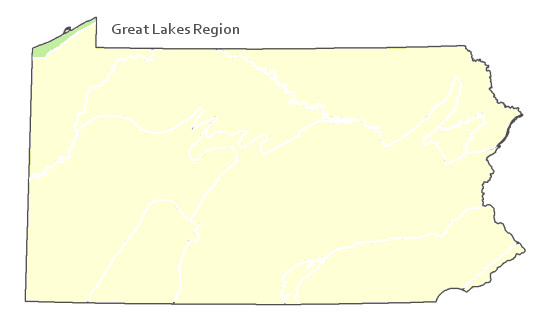
Pennsylvania Range
Northwestern Pennsylvania; limited to vertical bluffs along tributaries to Lake Erie.
Global Distribution
Northeastern Ohio to New York along the gorges of Lake Erie tributaries of its southern shore.
Fike, Jean. 1999. Terrestrial and Palustrine Plant Communities of Pennsylvania. Pennsylvania Department of Conservation and Natural Resources, Bureau of Forestry, Harrisburg, PA.
Hunt, D. M., G. J. Edinger, J. J. Schmid, D.J. Evans, P. G. Novak, A. M. Olivero,
and S. M. Young. 2002. Lake Erie Gorges Biodiversity Inventory & Landscape Integrity Analysis: A Final Report Prepared for the Central/Western New York Chapter of
The Nature Conservancy. New York Natural Heritage Program
Pennsylvania Department of Conservation and Natural Resources (DCNR). 1999. Inventory Manual of Procedure. For the Fourth State Forest Management Plan. Pennsylvania Bureau of Forestry, Division of Forest Advisory Service. Harrisburg, PA. 51 ppg.
Stone, B., D. Gustafson, and B. Jones. 2006 (revised). Manual of Procedure for State Game Land Cover Typing. Commonwealth of Pennsylvania Game Commission, Bureau of Wildlife Habitat Management, Forest Inventory and Analysis Section, Forestry Division. Harrisburg, PA. 79 ppg.
Western Pennsylvania Conservancy. 1993. Erie County Natural Heritage Inventory. Prepared for the Erie County Department of Planning, Erie, Pennsylvania.
Cite as:
Zimmerman, E. 2022. Pennsylvania Natural Heritage Program. River Bluff Seep Factsheet. Available from: https://naturalheritage.state.pa.us/Community.aspx?=30030 Date Accessed: March 28, 2025

